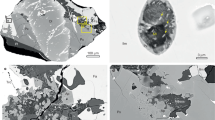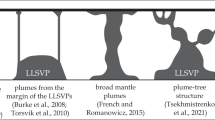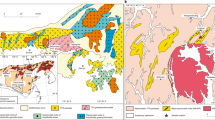Abstract
The mantle transition zone, located at depths of 410–660 km between the lower and upper mantle, is an important water reservoir in the Earth’s interior1,2,3,4. However, there are regional-scale heterogeneities in the distribution of water4,5. The zone beneath northeast China, in particular, is remarkably hydrous4, but when and how it became hydrous remains uncertain. Here we combine analyses of the geochemistry of late Cenozoic basalts in northeast China with published geochemical analyses. We find a spatial correlation between basalt geochemistry and the distribution of a low-velocity zone in the underlying mantle that is interpreted as a plume upwelling from the mantle transition zone6. We therefore use the basalt geochemistry to infer the composition of the mantle transition zone. The basalts have high Ba/Th and 207Pb/206Pb ratios, which we suggest record an ancient hydration event in the transition zone that occurred more than one billion years ago, probably as a result of dehydration of a subducted slab. We suggest that this ancient hydration event, combined with a more recent hydration event linked to dehydration of the subducted Pacific slab7, can account for the hydrous nature of the mantle transition zone beneath China. Our results demonstrate that the mantle transition zone can remain as a stable water reservoir in Earth’s interior for timescales of more than a billion years.
This is a preview of subscription content, access via your institution
Access options
Subscribe to this journal
Receive 12 print issues and online access
$259.00 per year
only $21.58 per issue
Buy this article
- Purchase on Springer Link
- Instant access to full article PDF
Prices may be subject to local taxes which are calculated during checkout


© 2009 Elsevier


Similar content being viewed by others
References
Smyth, J. R. β-Mg2SiO4: A potential host for water in the mantle? Am. Mineral. 72, 1051–1055 (1987).
Inoue, T., Yurimoto, H. & Kudoh, Y. Hydrous modified spinel, Mg1.75SiH0.5O4: A new water reservoir in the mantle transition region. Geophys. Res. Lett. 22, 117–120 (1995).
Ohtani, E., Litasov, K., Hosoya, T., Kubo, T. & Kondo, T. Water transport into the deep mantle and formation of a hydrous transition zone. Phys. Earth Planet. Inter. 143–144, 255–269 (2004).
Karato, S. Water distribution across the mantle transition zone and its implications for global material circulation. Earth Planet. Sci. Lett. 301, 413–423 (2011).
Utada, H., Koyama, T., Obayashi, M. & Fukao, Y. A joint interpretation of electromagnetic and seismic tomography models suggests the mantle transition zone below Europe is dry. Earth Planet. Sci. Lett. 281, 249–257 (2009).
Zhao, D., Tian, Y., Lei, J., Liu, L. & Zheng, S. Seismic image and origin of the Changbai intraplate volcano in East Asia: Role of big mantle wedge above the stagnant Pacific slab. Phys. Earth Planet. Inter. 173, 197–206 (2009).
Ohtani, E. & Zhao, D. The role of water in the deep upper mantle and transition zone: Dehydration of stagnant slabs and its effects on the big mantle wedge. Russ. Geol. Geophys. 50, 1073–1078 (2009).
Fukao, Y., Obayashi, M., Inoue, H. & Nenbai, M. Subducting slabs stagnant in the mantle transition zone. J. Geophys. Res. 97, 4809–4822 (1992).
Richard, G. C. & Iwamori, H. Stagnant slab, wet plumes and Cenozoic volcanism in East Asia. Phys. Earth Planet. Inter. 183, 280–287 (2010).
Chen, Y., Zhang, Y., Graham, D., Su, S. & Deng, J. Geochemistry of Cenozoic basalts and mantle xenoliths in northeast China. Lithos 96, 108–126 (2007).
Kuritani, T. et al. Intraplate magmatism related to deceleration of upwelling asthenospheric mantle: Implications from the Changbaishan shield basalts, northeast China. Lithos 112, 247–258 (2009).
Zindler, A. & Hart, S. Chemical geodynamics. Annu. Rev. Earth Planet. Sci. 14, 493–571 (1986).
Basu, A. R., Junwen, W., Wankang, H., Guanghong, X. & Tatsumoto, M. Major element, REE, and Pb, Nd and Sr isotopic geochemistry of Cenozoic volcanic rocks of eastern China: Implications for their origin from suboceanic-type mantle reservoirs. Earth Planet. Sci. Lett. 105, 149–169 (1991).
Gao, S. et al. Recycling lower continental crust in the North China craton. Nature 432, 892–897 (2004).
Murphy, D. T., Collerson, K. D. & Kamber, B. S. Lamproites from Gaussberg, Antarctica: Possible transition zone melts of Archaean subducted sediments. J. Petrol. 43, 981–1001 (2002).
Griffin, W. L., Andi, Z., O’Reilly, S. Y. & Ryan, C. G. in Mantle Dynamics and Plate Interactions in East Asia (eds Flower, M. F. G., Chung, S-L., Lo, C-H. & Lee, T-Y.) 107–126 (Geodynam. Ser. Vol. 27, American Geophysical Union, 1998).
Rehkämper, M. & Hofmann, A. W. Recycled ocean crust and sediment in Indian Ocean MORB. Earth Planet. Sci. Lett. 147, 93–106 (1997).
Hauff, F., Hoernle, K. & Schmidt, A. Sr–Nd–Pb composition of Mesozoic Pacific oceanic crust (Site 1149 and 801, ODP Leg 185): Implications for alteration of ocean crust and the input into the Izu–Bonin–Mariana subduction system. Geochem. Geophys. Geosyst. 4, 8913 (2003).
Fukao, Y., Widiyantoro, S. & Obayashi, M. Stagnant slabs in the upper and lower mantle transition region. Rev. Geophys. 39, 291–323 (2001).
Murphy, D. T., Kamber, B. S. & Collerson, K. D. A refined solution to the first terrestrial Pb-isotope paradox. J. Petrol. 44, 39–53 (2003).
Choi, S. H., Mukasa, S. B., Zhou, X-H., Xian, X. H. & Andronikov, A. V. Mantle dynamics beneath East Asia constrained by Sr, Nd, Pb and Hf isotopic systematics of ultramafic xenoliths and their host basalts from Hannuoba, North China. Chem. Geol. 248, 40–61 (2008).
Bercovici, D. & Karato, S. Whole-mantle convection and the transition-zone water filter. Nature 425, 39–44 (2003).
Rapp, R. P. et al. Subduction recycling of continental sediments and the origin of geochemically enriched reservoirs in the deep mantle. Earth Planet. Sci. Lett. 271, 14–23 (2008).
Ben Othmann, D., White, W. M. & Patchett, J. The geochemistry of marine sediments, island arc magma genesis, and crust–mantle recycling. Earth Planet. Sci. Lett. 94, 1–21 (1989).
Grove, T. L. & Parman, S. W. Thermal evolution of the Earth as recorded by komatiites. Earth Planet. Sci. Lett. 219, 173–187 (2004).
Withers, A. C. & Hirschmann, M. M. Influence of temperature, composition, silica activity and oxygen fugacity on the H2O storage capacity of olivine at 8 GPa. Contrib. Mineral. Petrol. 156, 595–605 (2008).
Le Pichon, X. Sea-floor spreading and continental drift. J. Geophys. Res. 73, 3661–3697 (1968).
Liu, J., Han, J. & Fyfe, W. S. Cenozoic episodic volcanism and continental rifting in northeast China and possible link to Japan Sea development as revealed from K–Ar geochronology. Tectonophysics 339, 385–401 (2001).
Stacey, J. S. & Kramers, J. D. Approximation of terrestrial lead isotope evolution by a two-stage model. Earth Planet. Sci. Lett. 26, 207–221 (1975).
Cousens, B. L. & Allan, J. F. A Pb, Sr, and Nd isotopic study of basaltic rocks from the Sea of Japan, LEGS 127/128. Proc. Ocean Drill. Program Sci. Results 127–128, 805–817 (1992).
Acknowledgements
We thank D. Zhao, S. Karato, and T. Yoshida for useful discussion, and K. Putirka for constructive comments. This work was supported by the program ‘Global Center of Excellence’ of Tohoku University.
Author information
Authors and Affiliations
Contributions
This paper is the product of research conducted by T.K. under the support of the program ‘Global Center of Excellence’ of Tohoku University. All three authors contributed to the interpretation of the data and to the writing of the manuscript.
Corresponding author
Ethics declarations
Competing interests
The authors declare no competing financial interests.
Supplementary information
Supplementary Information
Supplementary Information (PDF 1393 kb)
Rights and permissions
About this article
Cite this article
Kuritani, T., Ohtani, E. & Kimura, JI. Intensive hydration of the mantle transition zone beneath China caused by ancient slab stagnation. Nature Geosci 4, 713–716 (2011). https://doi.org/10.1038/ngeo1250
Received:
Accepted:
Published:
Issue Date:
DOI: https://doi.org/10.1038/ngeo1250
This article is cited by
-
Role of Large Igneous Provinces in continental break-up varying from “Shirker” to “Producer”
Communications Earth & Environment (2024)
-
Cenozoic potassic volcanic rocks from the Keluo and Wudalianchi volcanic districts, northeast China: origin from the new sub-continental lithospheric mantle (SCLM) metasomatized by potassium-rich fluids from delaminated lower crust
Frontiers of Earth Science (2022)
-
Understanding the Yanshan volcano eruption in the Chaihe–Arxan volcanic field, northeastern China
Arabian Journal of Geosciences (2021)
-
Deep mantle melting, global water circulation and its implications for the stability of the ocean mass
Progress in Earth and Planetary Science (2020)
-
Intraplate volcanism originating from upwelling hydrous mantle transition zone
Nature (2020)



